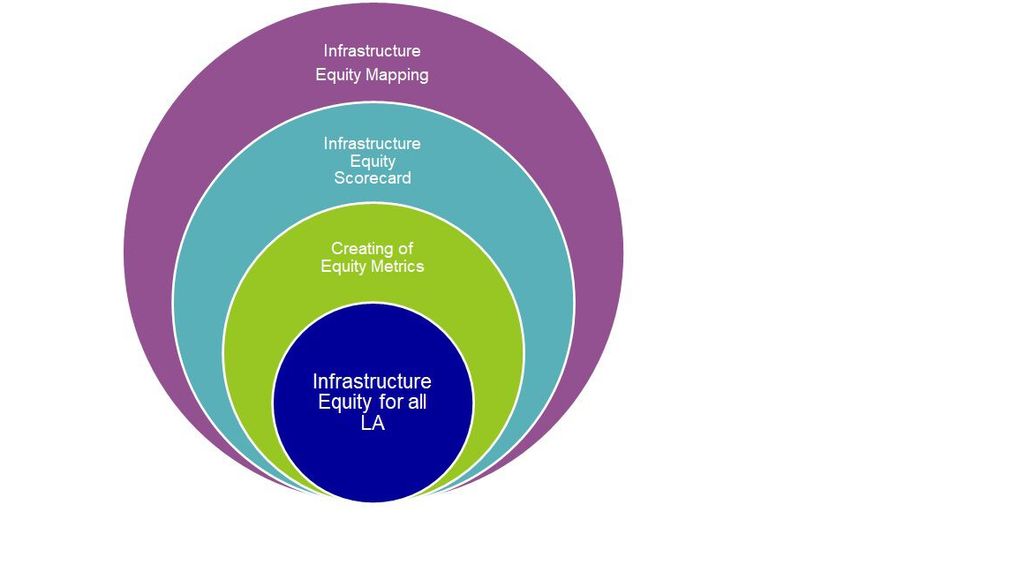Infrastructure Design with Equity in Mind: Tools for Scoring and Mapping
Our aim is to create an Equity Infrastructure Scorecard that aids in mapping concentrations of (in)equitable infrastructure across the city. This mapping is the first step in transforming every city engineering project into a more equitable system of support for all Angelenos. Beginning with a pilot project for three select systems the aim is to develop a process that helps agencies 1) understand and analyze existing infrastructural conditions, 2) identify gaps and needs, 3) direct resources, and 4) equalize access and distribution.

In which areas of Los Angeles will you be directly working?
City of Los Angeles
What is the problem that you are seeking to address?
The Bureau of Engineering invests millions of dollars each year engineering the stormwater, public parks, streets, and wastewater systems for all Angelenos, but aging infrastructure and uneven investment means that not every Angeleno has equitable access to basic infrastructure that supports a high quality of life. Too often, economically disadvantaged neighborhoods receive lower quality facilities or suffer through longer disruptions simply because, among other reasons, residents have less agency in the planning and decision-making process. The resulting landscape is uneven, yet how uneven and where that unevenness persists is not precisely known. An understanding of this uneven landscape, which requires better access to data, is the first step toward identifying need and increasing a more infrastructurally equitable city. This condition has been highlighted in the current pandemic, where access to space and connectivity in particular have favored the wealthy. It’s time to change that
Describe the project, program, or initiative that this grant will support to address the problem identified.
Inspired by Mayor Garcetti’s Executive Directive No. 27 and LA’s Green New Deal, Engineering hopes to spearhead a look outward, finding ways to better assess and transform our contribution to a more equitable built environment. The first step is to understand the existing condition by creating an Infrastructure Equity Scorecard, then use that knowledge to pinpoint areas of inequity through mapping, and, in the long run, work more closely with communities to build the systems that best serve their needs and bring all of LA’s infrastructure into the 21st century. Though data exists, bridging the silos between city agencies can be challenging. This project would create a team dedicated to a pilot mapping of three potentially interconnected systems -- sidewalks, stormwater, and parks and open space -- to model the scoring and mapping process for the City of LA. This Scorecard draws from existing sustainability assessment tools, which often only minimally focus on an equitable built environment, and tools and technology in development by our collaborators at Autocase. This collaborative Scorecard and Mapping would be the first step in Engineering’s objective to create a standard where every new infrastructure project is seen first through an equity lens.
In what stage of innovation is this project, program, or initiative?
Pilot or new project, program, or initiative
Approximately how many people will be impacted by this project, program, or initiative?
Direct Impact: 450
Indirect Impact: 4,000,000
Describe how Los Angeles County will be different if your work is successful.
An equity-first focus will impact the practice of hundreds of engineers and millions of residents across the City of LA. The Infrastructure Equity Scorecard and Mapping will initiate a conversation with all our contracting agencies and across public works, impacting billions of dollars of construction projects in all council districts. In the long range, the project will lead to more equitable distribution of resources by foregrounding a process that tracks infrastructure gains and losses and will give voice and agency to historically under-served residents. The Scorecard and Mapping are the first steps to identify a baseline of infrastructure conditions and distribution. The ultimate goal is an interactive, publicly available and adaptable mapping and assessment tool, which allows designers, engineers and residents to be proactive in the face of rising wealth disparity and climate challenges, the sum of which are exponentially disastrous.
What evidence do you have that this project, program, or initiative is or will be successful, and how will you define and measure success?
In the short term, the three measures of success include: 1) completion of research and gathering of data needed to fully analyze the current and historic conditions of the three systems; 2) establishing a set of metrics for the Scorecard; and 3) the completion of Infrastructure Equity Mapping to identify areas of most pressing need. Long-term successes include broad utilization of the mapping system for all five Bureau’s planning, design, and construction management activities to increase the level of infrastructure equity within Los Angeles. The mapping would also allow council districts and communities to leverage the equity mapping to procure additional resources and funding in historically under-served districts. The ultimate goal would be to have the Equity Infrastructure Scorecard and Mapping system applied across all city and county agencies. True success will come from realizing Engineering’s mission of delivering high quality services with equity in mind.
Describe the role of collaborating organizations on this project.
Linda Samuels, Director of the Infrastructural Optimism LAb based in LA and St. Louis, will be a project manager, guide the project concept, and coordinate among partners, collaborators and agencies. As an urban design researcher, her work focuses on next generation infrastructure and leveraging infrastructure investment for greater social and environmental gain. The project research team will include experts assisting in the collection of data and spatial mapping. Simon Fowell, Principal Economist at Autocase, brings several years of experience building sustainability tools to support the collection of data and develop metrics. Their multi-criteria analysis systems currently help identify co-dependent disparities in systems such as transit, recreation, and healthcare.
Which of the CONNECT metrics will you impact?
Government responsiveness to residents’ needs
Neighborhood council participation
Disability access and inclusion
Indicate any additional LA2050 goals your project will impact.
LA is the best place to PLAY
LA is the healthiest place to LIVE